 | E-mail to Birds Korea |
 | KWBS |
in the Region
 | The Oriental Bird Club |
 | BirdLife International (Asia) |
August
Typically hot and humid (with day maxima often around 30°C until at least mid-month), with occasional heavy rains and strong winds, associated either with southern typhoons or caused by the mix of humidity and heat.
Chinese Egrets become widespread along the west coast. Shorebirds (including a very small number of Spoon-billed Sandpiper) begin to build up at many of the remaining best sites. Numbers tend to be rather lower than in spring, though Kentish Plover and Terek Sandpiper often number in the thousands in the southwest.
Parties of Black-naped Orioles, the appearance of returning leaf warblers (especially Eastern-crowned and Arctic Warblers) and small numbers of Brown Shrike and Yellow-rumped and Brown Flycatchers by mid-month also hint at the start of passerine migration, while Eurasian Hobby and Chinese Sparrowhawks appear to be on the move by the month's end. At the very end of August, the first migrant Pechora Pipit (probably of the subspecies menzbieri) and migrant buntings also appear on offshore islands especially.
Seabirds have provided most interest in recent Augusts, with three records of Sooty Tern, Korea's first Sooty Shearwaters (in 2002), and a Lesser Frigatebird overflying Socheong and Korea's first Aleutian Tern seen from the Socheong ferry in 2004, with another in 2006.
(The following records are a compilation of our own sightings and records sent in by other observers. As well as being posted on the Birds Korea website(s), selected records are also forwarded to other Korean-language birding websites; records of threatened species are arranged and forwarded to Birdlife International and national authorities when appropriate; flag images and records are passed to bodies responsible for their coordination throughout the flyway; and all records sent to us are used to compile annual reports and to support the evolving understanding of the status of many of Korea’s birds.)
This spring saw good numbers of different taxa of both Brown Shrike Lanius cristatus and Pechora Pipit Anthus gustavi migrating through South Korea. Identification issues encountered because of their variability has prompted Nial Moores to write two articles that raise some very interesting questions... go to Brown Shrikes and go to Pechora Pipits
Guryongpo Peninsula, August 30
With typhoon Chaba veering away from a forecast track which would have brought it close to Korea, winds reached a strong Beaufort 6 only, though there was significant sea swell with 3 to 4 m waves.
A constant line of Streaked Shearwater moving north against the wind peaked at 830 per hour in the morning (many seen excellently well), while terns moving east past the headland averaged about 50 per hour, with all of the very few seen well being Common Tern. With the exception of 3 Phalarope (presumed Red-necked) no other seabirds of note were seen during the morning, after which the wind swung round to the northwest, reducing visible shearwater movement considerably.
On the main beach, a flock of ca 500 Black-tailed Gull contained 35 Black-headed (including two juveniles), 6 Mongolian Gull (second calendar year and older), one Mongolian or Vega 2nd summer type, and no less than 14 Slaty-backed Gull, including one fresh juvenile: with closest known breeding colonies suspected to be in Far East Russia and Hokkaido, a juvenile Slaty-backed Gull seen so far south in August seems especially noteworthy.
Jongdal-ri in Jeju, August 30
10 Yellow Wagtail (including 2 Motacilla flava taivana - taxonomy of "Eastern" yellow wagtails remains complex, and we aim to put together some notes on the subject in the near future.)
Guryongpo Peninsula, August 29
In anticipation of typhoon Chaba, an afternoon of seawatching at Daebo on the Guryongpo Peninsula.
With only moderate to strong northeasterlies and fair conditions, few birds of note, with for example 96 tern (most distant; all presumed to be Common), and 420 Streaked Shearwater past in the first hour of counting. The only other birds of note included 2 adult Slaty-backed Gull, 3 Black-headed Gull and 1 female type Russet Sparrow in the harbor area.
Seosan, August 28
A number of interesting records included 29 White-winged Terns and a Whiskered Tern.
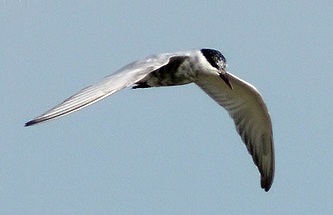
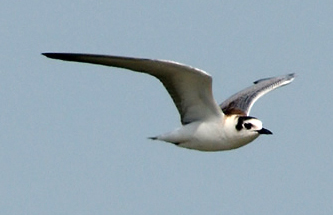
Socheong Island am, ferry back to Incheon pm, August 23
An excellent day! During the heavily overcast night several shorebirds (including Grey Plover, Common Redshank and Pintail Snipe) could be heard calling, along with several Striated Heron and many “grey-brown” flycatchers, the latter passing overhead at a rate of perhaps ca 1 per minute. During the early morning, with clearing skies and very high visibility (well in excess of 100 km), at least 80 Brown and 10 Dark-sided Flycatchers (the latter including 4 juveniles) were logged in the west of the island, with many of these moving back east up the island shortly after dawn. In addition, 45 Yellow-rumped Flycatcher and new seasonal highs of 14 Forest Wagtail and 15 Pale-legged/Sakhalin Leaf Warbler were made. Further species of note included ca 12 Light-vented Bulbul still (with one group of 4 juveniles making very short forays out over the sea near the lighthouse, and another group of ca 8, containing two adults, one still singing, in “second village”) a juvenile or first winter Siberian Blue Robin (very scarce on offshore islands in autumn), single Blyth's and Pechora Pipits, and single Yellow-breasted and Yellow-browed Buntings (both personal firsts of the autumn).
The excellent morning's birding, however, was topped by the high-speed ferry crossing in the afternoon, with new high counts made of both Swinhoe's Storm Petrel (178) and “Common” Tern (921) and a range of other good species noted, including 3 Flesh-footed and 2 Short-tailed Shearwaters and the first Pomarine Skua of the autumn. Outstanding highlight, however, was South Korea's first record of Aleutian Tern Sterna aleutica: an adult, moving from breeding into non-breeding plumage, sitting on a buoy ca 70 Km East-Southeast of Socheong Island. For details of this exciting record, go to Aleutian Tern - new for South Korea.
Socheong Island, August 22
Although rain was forecast, the day sadly turned out sunny and rather warm (with a high of about 26C), and again many migrants seemed to have moved on. Forest Wagtail reached a new “high” for this season of 5, Arctic Warbler of 30, and Yellow-browed Warbler of 2, while highlights for the day included very brief glimpses of single Lanceolated and Grays Grasshopper Warblers.
Of relative interest were a juvenile Yellow-rumped Flycatcher with strongly yellow-washed underparts (rather recalling the illustration of female elisae in Robson's “Birds of South-east Asia”, but with a yellow rump), and also a pair of Peregrine, the male of which appeared dark and to show rather more blackish on the head than is perhaps typical for the local japonensis subspecies.
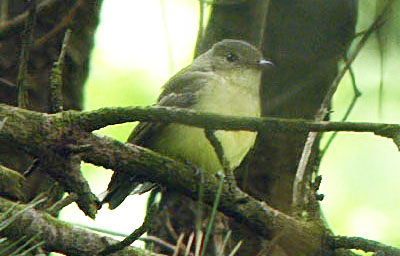
Socheong. © Nial Moores.
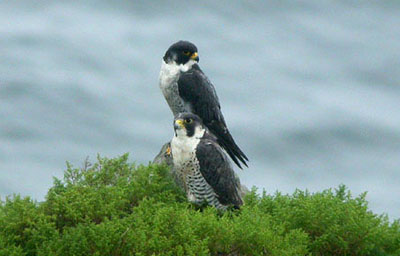
Socheong Island, August 21
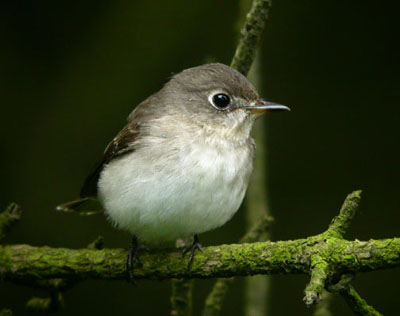
Largely clear conditions overnight were replaced by thick overcast at dawn, with mist, fog patches and even some spots of rain, causing another small fall. Typical migrants were well-represented, with for example 8 Thick-billed and 65 Brown Shrikes in the west of the island, along with 50 Yellow-rumped and 60 Brown Flycatchers. Birds of especial note included 3 Forest Wagtail, 5 Richards and 2 Pechora Pipits, a Wryneck, a Siberian Rubythroat and 2 Chestnut-cheeked Starling (the last four species all personal firsts of the autumn), and 3 Thick-billed Warbler, while the small beach held both a single Sanderling and 2 Red-necked Stint in the evening.
Socheong Island, August 20
Calm conditions with sunny periods and temperatures still above 25 C meant that many of yesterday's migrants had likely moved on, with only a single Thick-billed and 5 Brown Shrikes logged during the day. Other birds of note included a single Japanese Lesser Sparrowhawk (moving east), 3 Chestnut Bunting and at least 11 Light-vented Bulbul.
Mangyeong River, Geum River and Oh-seong Mountain, August 22
Sharp-tailed Sandpipers and Red-necked Stints were seen at the Mangyeong. Also, both Spotted and Common Redshank, Bar-tailed and Black-tailed Godwits and several Common Snipe were seen. Near the airport I would estimate 1500-2000 Far Eastern Curlew were seen at distance.
Large groups of tits and other small forest birds foraged over Oh-seong Mountain, and we enjoyed waves of Long-tailed , Marsh, Varied, Coal and Great Tits in the company of Artic Warblers.
At the Geum, both Kingfishers persisted and PN glimpsed a Green Sandpiper.
Geum River Estuary and Oh-Seong Mountain, August 21
Both a Black-capped and a Common Kingfisher were seen in the channels near the Geum River. Around the mountain four kinds of Woodpeckers were seen including White-backed. A large group of Azure-winged Magpies were mingling in the same trees with a dozen or more mostly immature Black-napped Orioles. A few Eurasian Jays in the same copse behind a pond with summer plumaged Little Grebes, lotus flowers and some Moorhens made for a colorful display.
Jeju Island, August 21
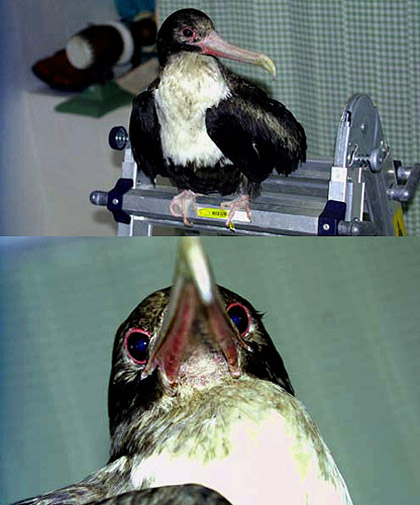
As a result of typhoon Maegi, a female Great Frigatebird - a first record for Korea - was picked up exhausted from a sea breakwater on Jeju Island on August 19th, and taken into care. It has subsequently recovered (per KANG Chang Wan) - this record comes only 10 days after a Lesser Frigatebird Fregata ariel was photographed on Socheong Island ca 500 km to the north and 6 days after a dead Bonin's Petrel was found dead on Jeju.
For details go to Great Frigate - first for Korea.
Socheong Island, August 19
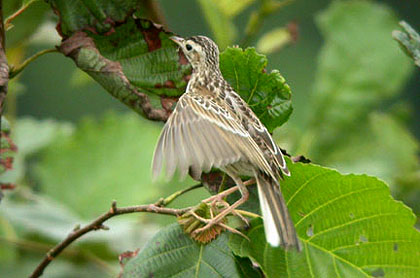
Heavy overnight rain gave way to clear skies by evening as a weak typhoon moved through the Korean Straits.
The autumn's first small fall produced ca 55 Brown and 2 Thick-billed Shrikes, 20 Arctic, 5 Pale-legged, 3 Eastern Crowned and 1 Styann's Grasshopper Warbler, 25 Yellow-rumped Flycatcher (with 2 Dark-sided and 4 Brown), 2 Common Rosefinch, 2 Chestnut Bunting, a Chinese Grosbeak, 6+ Richard's and 1 apparent Blyth's Pipit (heard once only in flight), and a very high count of ca 1 000 Pacific Swift in the evening.
Socheong Island, August 18
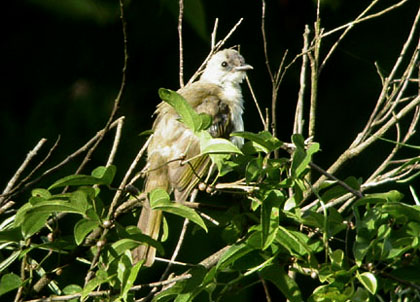
After two days of rain, a quick trip out to Socheong to look for early migrants.
From the ferry, 180 Streaked Shearwater, 111 Common Tern, and best of all 148 Swinhoe's Storm Petrel (easily the highest number seen on this crossing). In addition, 1 Flesh-footed and 2 Slender-billed Shearwater seen (with 2 more of the latter from the island itself).
On Socheong, a few birds, with most interesting including a Little Cuckoo, 2 Forest Wagtail, a juvenile Richard's Pipit, a Thick-billed Warbler and 10 Yellow-rumped Flycatcher. Best of all, however, were at the very least 14 Light-vented (Chinese) Bulbul (with one group of 8), most of which were juveniles...
Jeju Island, August 15
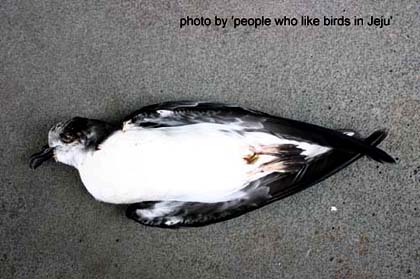
Following Typhoon Maegi a Bonin Petrel Pterodroma hypoleuca has been found dead on a road on Jeju, and subsequently photographed by KANG Chang Wan. This is possibly only the second record of the species in South Korea (with the first record described in 1999 by Lee, Woon and Kim in the Korean Journal of Ornithology: 6: 133-134).
Made by Thomas Heinicke (TH), Jurgen Steudtner (JS), Nial Moores (NM)
August 01, Saemangeum (TH, JS and NM) 35 D N 50 N, 126 D 45 E
- Grey-tailed Tattler: ONE, yellow on upper leg (right or left?)
- Ruddy Turnstone: ONE, orange possibly on lower leg (right or left?), nothing above
August 02, Saemangeum (TH, JS and NM)
- Red Knot: ONE orange on right upper
- Great Knot: ONE, Left upper white; orange below;
- Ruddy Turnstone: ONR, Right upper (red)/orange; nothing lower
- Bar-tailed Godwit: TWO, both with yellow upper right leg, nothing lower
- Bar-tailed Godwit: TWO, both with white upper, nothing noted lower
- Kentish Plover: ONE. White upper, orange lower (lower flag VERY hard to see!).
August 12, Ganghwa Island, Gyeonggi Province (TH and JS) Approx. 37 D 35 N, 126 D, 27 E.
Terek Sandpiper: One, with Yellow upper.
August 13, Yeongjong Island, Incheon, 37 D 35 N, 126 D 32 E
- Red-necked Stint: ONE reddish-orange upper right leg
- Terek Sandpiper: Yellow Upper right
- Bar-tailed Godwit: Yellow Upper right.
For a breakdown of the "flag colour" protocol devised by the Australasian Wader Study Group and now used by banders in the East Asian/Ausralasian Flyway, go to Flag Protocols.
Yeongjong, August 13
Rather fewer shorebirds than 2 weeks previous, but still 3 leg-flagged shorebirds noted (with details of these and other sightings already sent to the AWSG for processing).
Ganghwa Island, August 12
Improved numbers of typical autumn birds on the tidal-flats, including now 56 Black-faced Spoonbill, 25 Saunders's Gull (including 8 juveniles), 3 juvenile Great Knot and a strikingly small Nordmann's Greenshank.
In rice-fields, 3 Chinese Pond Heron (with one further individual also seen there on the 11th), and at least 15 Pintail Snipe (Thomas and Jurgen's 44th shorebird species in Korea in only 3 weeks!).
Socheong Island, August 11 AM
Before the boat back to the mainland at midday, few passerines seen, with best being a single Thick-billed Shrike and single Eastern Crowned and Arctic Warblers.
Undoubtedly, the most significant observation was of a very young juvenile Light-vented Bulbul begging food from an adult, within the territory held by a pair of bulbuls into June: very strong evidence of local breeding, and success.
From the ferry back to Incheon, only 10 Streaked Shearwater, but probably 5 Swinhoe's Storm Petrel, several giving very good views.
Socheong Island, August 10
In the first few hours of light (before temperatures climbed to a humid high of 31 C) a few early autumn migrants included a single Brown Flycatcher, single Styann's and Middendorff's Grasshopper Warblers, a Hoopoe and ca 8 juvenile Brown Shrike.
Birds "left over" from the spring included a Common Buzzard and also Light-vented/Chinese Bulbul. No less than 4 Light-vented/Chinese Bulbul were seen during the day, and all were presumed to be juveniles. Considering that the species was only first recorded in South Korea in 2002, and that at least one pair appeared to be vocal and in territory on Socheong into early June (their continued presence "supressed" in order to protect a possible nesting attempt from disturbance by photographers or others), it seems very likely that these were locally raised birds, perhaps consitituting the first nesting record of the species in South Korea.
Socheong Island, August 9
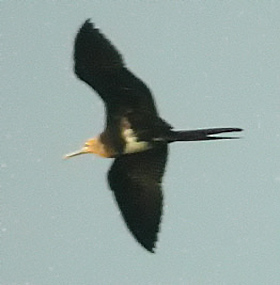
© Juergen STEUDTNER.
A lunchtime ferry ride with no outdoor access meant that only Streaked Shearwater were visible at sea. From the island itself, many more Streaked Shearwater, but only very small numbers of grounded migrants, with for example a single Brown Shrike and much less expected a Swinhoe's Snipe flushed at close range.
Outstanding highlight, however, was a juvenile Lesser Frigatebird watched circling the northern coast of the island in the evening. There are, as might be expected, very few previous records of frigatebirds in South Korea.
For a series of photographs and ID text go to: Frigatebird
Seosan, August 7 and 8
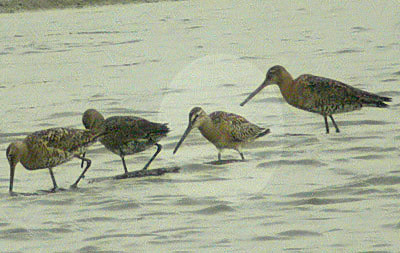
Highlights included probably the first juvenile Asiatic Dowitcher (TH and JS) ever recorded at Seosan, a Latham's Snipe (TH and JS), the earliest autumn record or first summering record of Long-tailed Shrike (KH), and a dark morph Little Egret (KH).
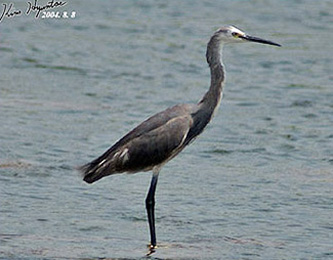
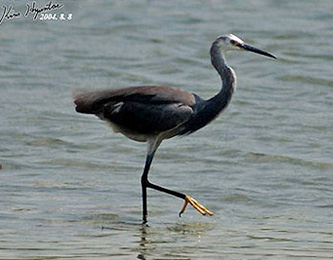
This individual is likely to be of considerable interest to those debating the occurrence or otherwise of dark-morph Little Egret (e.g van den Berg in Dutch Birding 21:8-15, 1999).
In addition, TH and JS also observed a single very pale Sand Martin-type in flight, which based on their previous experience in Kazakhstan, strongly suggested Pale (Sand) MartinRiparia diluta, a taxon as yet unrecorded in Korea.
East coast near Sokcho, August 6
An Asian Short-toed Lark on the coast there is considered an exceptional record for the time of year (the very few recent records being claimed in winter).
Seosan, August 5
On Lake A, 3 Oriental Pratincole (2 adults and 1 juvenile) found, along with a good range of other shorebirds, including 8 or 9 Long-toed Stint.
Eocheong Island, August 3 and 4
Too early for much evidence of migration, with only obvious migrants being Siberian Stonechat and Hoopoe. The ferry crossing, however, produced good views of Streaked and a few Slender-billed Shearwaters.
Jeju Island and around Chungju, July 30 - August 4
I visited Jeju Island from July 30 to August 4. The weather was hot and not particularly good for birding.
July 30, I flew from Cheongju Airport to Jeju City. At Cheongju Airport is a roost for Cattle Egrets. Other birds seen there included White Wagtails, Grey Starlings, Tree Sparrows, Rufous Turtle Doves and Black-billed Magpies. Around Jeju City I saw Tree Sparrows, Brown-eared Bulbuls, Barn Swallows, Rufous Turtle Doves, Black-billed Magpies and a Blue Rock Thrush. There were Bulbuls having a bath in the fountain at the Natural History Museum.
July 31, I took a bus to Seongsan-ri along the north of the island. I saw more Barn Swallows, Tree Sparrows, Brown-eared Bulbuls and Black-billed Magpies. Along the road I also saw Jungle Crows and in stream a Grey Heron. I went to Sunrise Peak at Seongsan-ri in the afternoon and saw two Blue Rock Thrushes and above the rocks were two raptors. I later had excellent views of a Peregrine Falcon perched in a tree on the small hill southwest of Seongsan Harbor. This hill also had Japanese White-eyes, Rufous turtle Doves and Ring-necked Pheasants. After dark I walked along the harbour wall and could see gulls flying around the squid fishing boat but they were too far away for me to identify.
August 1, I moved to Seagwipo and went for a walk from the harbour area around the shore to Oedolgae. Going to the waterfall near the harbour I could hear Japanese White-eyes, Brown-eared Bulbuls and Rufous Turtle Doves. Late in the afternoon at low tide, I saw 4 Pacific Reef Herons, a Grey Heron and a Little Egret foraging in the shallow water flowing into the harbour downstream from the waterfall. I saw the Grey Heron catch a puffer fish. The fish inflated itself to about 15 centimetres diameter. After puncturing the fish with its beak the heron abandoned the fish among the rocks. The Reef Herons appeared to be catching small fish and I noticed one using foot trembling behaviour to disturb hidden prey in the shallow water.
August 2, I saw Barn and Red-rumped Swallows from my motel room in the morning. I visited Yeomiji botanical gardens and the waterfalls in the adjacent river. Around the gardens I saw Barn Swallows, Tree Sparrows, Japanese White-eyes, Brown-eared Bulbuls, Jungle Crows, Rufous Turtle Doves and a Blue Rock Thrush. Along the river were more White-eyes and Bulbuls. I stayed at Daejeong-ri and walked to Halla Beach in the afternoon. Here I saw a Grey Heron and a gull I couldn't identify. In the evening I walked down to the harbour area and found 2 Grey-tailed Tattlers on the rocks. Just on dusk there were several hundred Barn Swallows flying around over the main urban area.
August 3, I met two local birdwatchers at Donnaeko and was taken to see nests of Japanese White-eyes and Fairy Pittas on the soouthern side of Halla Mountain. They also took me to see a nest of Fan-tailed Warblers near Daejeong-ri. Other birds seen at Halla Mountain included Jungle Crow, Meadow Bunting, Ring-necked Pheasant, Brown-eared Bubul and Rufous Turtle Dove. We also heard the call of a Little Cuckoo.
August 4, I left Jeju Island. I didn't see any more species to mention.
Around Chungju
Summer birding around Chungju hasn't been as good this year, partly due to a lack of birds on Daejeji. This year has seen lots of people fishing there which has discouraged birds from visiting the site. Spot-billed Ducks did managed to produce two broods of young there.
There has been a pair of Eurasian Hobbies occupying a Magpies nest in the radio tower near Daejeji. The first Hobby was seen on May 19 and they were also recorded at Dal Cheon during the last couple of months. I saw the 2 Hobbies at the nest on August 7.
Other birds of interest seen at Daejeji on May 27 included Striated Heron, Black-crowned Night Heron, Moorhen and Little Grebe, the last two were seen with offspring.
I saw a pair of Black-capped Kingfishers on June 29 and a pair of Chinese Sparrowhawks on May 27, June 1and June 15 along the stream following into Daejeji.
At Dal Cheon a Ruddy Crake was seen on May 28, a Hoopoe was seen on June 1 and June 18. After the first flood, Oriental Great Reed Warblers had reduced in numbers on June 24 and had apparently gone by July. Korean Bush Warblers were still present in the area on August 7. The number of Broad-billed Rollers had increased to 7 on July 9 but none were seen on August 7.
Elsewhere around Chungju I saw 8 juvenile Ring-necked Pheasants on June 22 and Grey Starlings were seen forming flocks of over 50 on June 22 and June 29.
Chungju Namsan has had many Pale Thrushes calling through June and July. I've also seen Blue and White Flycatchers, Hazel Grouse, Jays, Long-tailed Tits, Coal Tits, Marsh Tits, Great Tits, Varied Tits, Jungle Crows, Eurasian Nuthatch, Yellow-throated Buntings, Grey-headed Woodpecker and Japanese Pygmy Woodpeckers there over the last few months.
I heard Oriental Scops Owls calling during a nocturnal walk on July 25 and I have seen Brown Hawk Owls catching insects attracted to the bright lights that shine on the new pedestrain bridge crossing the main road at Hoamji.
Dongjin estuary and Okku, Mangyeung (Saemangeum estuarine system), August 2
In continuing hot (33C) and humid weather, again excellent numbers of shorebirds, with the first personal Pacific Golden Plover of the autumn, and at Okku a presumed non-breeding (second calendar year?) Nordmann's Greenshank in with a flock of 75 Common Greenshank (although the legs of this sleeping bird were not seen, a single wing-lift revealed glossy white underwings, while at rest the tertials also showed obvious white triangular notches). Also on the tidal-flat at Okku, another near breeding-plumaged Spoon-billed Sandpiper was seen very briefly by TH, while the flock of 200 Bar-tailed Godwit there contained several birds with leg flags (details to be posted later).
Other birds of note included 5 very distant spoonbill on the Mangyeung (all presumed to be Black-faced), 4 adult Whiskered Tern on the Dongjin, and a juvenile Common Cuckoo perched out on a fishing boat there.
Gunsan, August 1
A Chinese Little Bittern was seen in the industrial area of Kunsan. Groups of Azure-winged Magpie were seen around Oh-seong Mountain. Six or more Ruddy Turnstone were seen on the tidal mud of the Man-gyeong River. There were also many Bar-tailed Godwits there.
Dongjin and Mangyeung (Saemangeum estuarine system), woodland in Gunsan and the Geum estuary, August 1
In very hot and humid conditions (with a high of ca 35C), 70 species were logged, including 2 Eastern Crowned and a single Arctic Warbler in Gunsan, a Black-faced Spoonbill, and a juvenile White-winged Tern on the Dongjin.
27 species of shorebird were found during the day, and numbers appeared very high for early autumn (though few counts seem to have been conducted so early in this season). Some internationally important or nationally significant counts included 600 Mongolian Plover and 4 500 Black-tailed Godwit on the Dongjin with a further 800 on the Mangyeung; 65 Common Redshank on the Dongjin (nationally important number, and perhaps a record high count?); 250 Terek Sandpiper on the Geum, with a further ca 3 000 at a few points within Saemangeum; and ca 18 000 Great Knot in total. Other further excellent shorebird records included a single adult Asiatic Dowitcher on the Dongjin (considered scarcely annual in South Korea), leg-flagged Grey-tailed Tattler and Ruddy Turnstone, 4 Greater Sandplover, and most exciting of all at least 2 breeding-plumage Spoon-billed Sandpiper on the Dongjin (both first picked out by and digi-scoped by JS).
These are the earliest records known to Birds Korea of Spoon-billed Sandpiper in South Korea, and once-again prove that even though the Okku roost has been destroyed, Saemangeum still remains a globally-important site demanding increasingly strong and urgent calls for its conservation.





